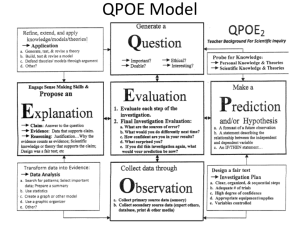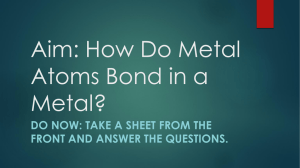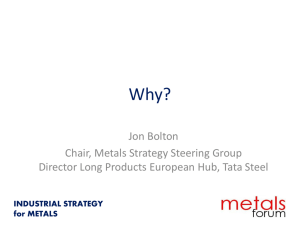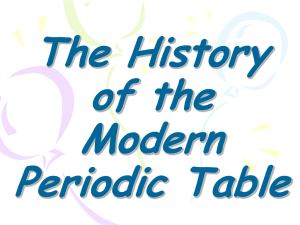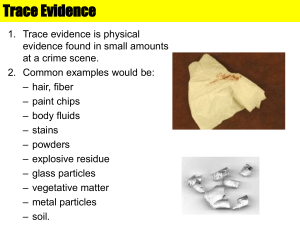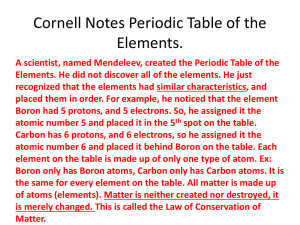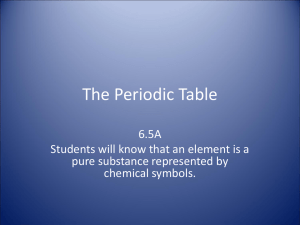SCI_MODULE_01b(ii)_MATERIALS_ PERIODIC_TABLE
advertisement
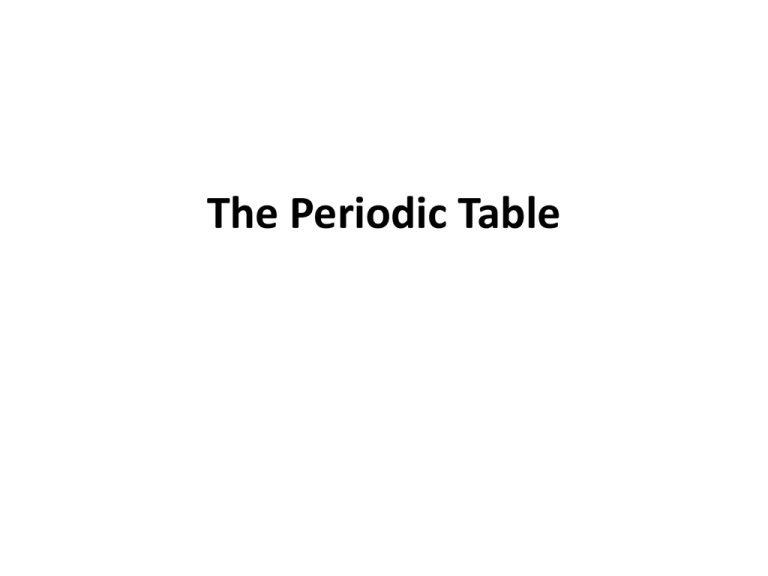
The Periodic Table The periodic table • is a table of the chemical elements in which the elements are arranged by order of their atomic number • it is arranged so that the periodic properties (repeating properties) of the elements are made clear. • The standard form of the table includes periods (usually horizontal in the periodic table) • and groups (usually vertical). • Elements in groups have some similar properties to each other. • http://www.colorado.edu/physics/2000/periodic_table/valences.html • This has a quiz you might like to try • http://www.elementsdatabase.com/ Describe the way the Periodic Table classifies elements in order of proton number. • http://www.grandinetti.org/Teaching/Chem12 1/Lectures/PeriodicTable • This link gives you some history of the periodic table • In the periodic table the elements are aranged in order of their proton number Describe the change from metallic to non-metallic character across a period • Non-metallic properties increase from left to right • On the left elements have only a few electrons in the outer shell • And become stable by giving them away • On the right they have more in the outer shell and become stable by accepting electrons to fill the shell • There are three types of elements • Here is the boundary between them Periodic trends Periodic properties • Elements in the same group have similar properties • In groups one and two the reactivity of the elements increases down the group • On the other side of the table in group 7 the reactivity decreases down the group • The noble gases (group 0) have a full outer shell of electrons and won’t react with any other element • You should be able to draw out the electronic structures for the first 20 elements if you know the proton and nucleon number • http://www.bbc.co.uk/schools/gcsebitesize/scie nce/add_ocr_pre_2011/periodic_table/element srev1.shtml • http://www.ptable.com/ Describe the relationship between Group number, number of outer-shell (valency) electrons and metallic/non-metallic character. • The group number tells us how many electrons are in the outer shell • Metals donate electrons when they ract • Non-metals accept electrons when they react • The number of electrons that can be given away or accepted is known as the valency Use the Periodic Table to predict properties of elements by means of groups and periods. • In each group the elements have similar properties • eg in group 1 the reactivity increases down the group, but all show similar reactions Group properties http://www.bbc.co.uk/schools/gcsebi tesize/science/add_ocr_pre_2011/pe riodic_table/ Describe lithium, sodium and potassium in Group I as a collection of relatively soft metals showing a trend in melting point and reaction with water. • http://www.youtube.com/watch?v=GVoJZkmAAfA • This video shows you the reaction of the group 1 metals with water Group 1 properties • All soft metals that are easily cut with a scalpel or knife. • The freshly cut surface is a shiny, silver colour, it quickly tarnishes to a dull grey as the metal reacts with oxygen and water in the air. • Pieces of such metals are stored in oil to prevent these reactions. • The shiny surface of sodium tarnishes more quickly than that of lithium. • And potassium tarnishes more quickly than sodium. • This shows the increasing reactivity of the metals as we go down the group. Reaction with cold water • All the alkali metals react vigorously with cold water. • In each reaction, hydrogen gas is given off and the metal hydroxide is produced. • The speed and violence of the reaction increases as you go down the group. • This shows that the reactivity of the alkali metals increases as you go down Group 1. Lithium • When lithium is added to water, lithium floats. It fizzes steadily and becomes smaller, until it eventually disappears. • lithium + water → lithium hydroxide + hydrogen • 2Li(s) + 2H2O(l) → 2LiOH(aq) + H2(g) Sodium • When sodium is added to water, the sodium melts to form a ball that moves around on the surface. • It fizzes rapidly, and the hydrogen produced may burn with an orange flame before the sodium disappears. • sodium + water → sodium hydroxide + hydrogen • 2Na(s) + 2H2O(l) → 2NaOH(aq) + H2(g) Potassium • When potassium is added to water, the metal melts and floats. • It moves around very quickly on the surface of the water. • The hydrogen ignites instantly. • The metal is also set on fire, with sparks and a lilac flame. • There is sometimes a small explosion at the end of the reaction. • potassium + water → potassium hydroxide + hydrogen • 2K(s) + 2H2O(l) → 2KOH(aq) + H2(g) Predict the properties of other elements in Group I, given data where appropriate • http://www.bbc.co.uk/schools/gcsebitesize/science/add_ocr_ pre_2011/periodic_table/group1rev1.shtml • You may be given data and asked to predict the properties of other members of the group Group 7 – the halogens • The elements in Group 7 of the Periodic Table are called the halogens. • They include chlorine, bromine and iodine. The halogens are diatomic - this means they exist as molecules, each with a pair of atoms. Chlorine molecules have the formula Cl2, bromine Br2 and iodine I2. Describe the trends in properties of chlorine, bromine and iodine in Group VII including colour, physical state and reactions with other halide ions. • The electronegativity of halogens decrease down the group. • Fluorine is the most reactive • The halogens boiling points increase down group seven. • This is because the atoms get bigger and so the Van der Waals forces get smaller. • So fluorine is a gas, bromine is a liquid and iodine is a solid • The oxidising power of the halogens decreases from Fluorine to Iodine. • This property can be demonstrated by displacement reactions. • a halogen higher up the will displace a lower one • For example, when chlorine is added to Br-(aq), the following reaction takes place. • 2Br-(aq) + Cl2 ® 2Cl-(aq) + Br2 Predict the properties of other elements in Group VII, given data where appropriate • Reactivity here decreases down the group • Remember the opposite is the case in group 1 • http://www.bbc.co.uk/schools/gcsebitesize/science/add_ocr_ pre_2011/periodic_table/group7rev1.shtml Displacement reactions • When chlorine (as a gas or dissolved in water) is added to sodium bromide solution the chlorine takes the place of the bromine. • Because chlorine is more reactive than bromine, it displaces bromine from sodium bromide. • The solution turns brown. • This brown colour is the displaced bromine. • The chlorine has gone to form sodium chloride. • If you look at the equation, you can see that the Cl and Br have swapped places. • chlorine + sodium bromide → sodium chloride + bromine • Cl2(aq) + 2NaBr(aq) → 2NaCl(aq) + Br2(aq) Videos of elements • http://www.periodicvideos.com/ • Here are some videos of elements in the periodic table • Have a look at some of them • Form group 1 – Li, Na, K and Fr • From groups 2 – Mg Ca • From group 7 – F, Cl Br and I Transition elements Describe the transition elements:• • • • • as a collection of metals having high densities, high melting points forming coloured compounds, and which, as elements and compounds, often act as catalysts The transition metals • http://www.bbc.co.uk/schools/gcsebitesize/sc ience/edexcel_pre_2011/patterns/transitionm etalsrev1.shtml • The elements in the centre of the periodic table, between groups 2 and 3, are called the transition metals. • Most of the commonly used metals are there, including iron, copper, silver and gold Common properties • The transition metals have the following properties in common: • they form coloured compounds • they are good conductors of heat and electricity • they can be hammered or bent into shape easily • they are less reactive than alkali metals such as sodium • they have high melting points - but mercury is a liquid at room temperature • they are usually hard and tough • they have high densities Noble gases http://www.bbc.co.uk/schools/gcsebi tesize/science/aqa_pre_2011/oils/ch angesrev6.shtml Group 0 – noble gases • Argon makes up about 0.9 per cent of the air. • It is one of a group of elements called the noble gases. • The noble gases are in Group 0 of the periodic table. • The noble gases are all chemically unreactive gases. Describe the noble gases as being unreactive • The noble gases are all chemically unreactive gases. • This is because they have a full outer shell (i.e. 8 electrons) Noble gases Describe the uses of the noble gases • in providing an inert atmosphere, • i.e. argon in lamps, • helium for filling balloons. The main uses of the noble gases Helium • Used in balloons and airships. • It is much less dense than air, so balloons filled with it float upwards. Neon • Used in advertising signs, it glows when electricity is passed through it. • Different coloured neon lights can be made by coating the inside of the glass tubing of the lights with other chemicals. Argon • Used in light bulbs. • The very thin metal filament inside the bulb would react with oxygen and burn away if the bulb were filled with air instead of argon. • Argon stops the filament burning away because it is unreactive. Krypton • Used in lasers. Krypton lasers are used by surgeons to treat certain eye problems • and to remove birthmarks Metals Properties of metals Distinguish between metals and non-metals by their general physical and chemical properties. • See next slides • http://hyperphysics.phyastr.gsu.edu/hbase/pertab/metal.html METALS NONMETALS Appearance Shiny Dull State at room temperature Solid (except mercury, which is a liquid) About half are solids, about half are gases, and one (bromine) is a liquid Density High (they feel heavy for their size) Low (they feel light for their size) Strength Strong Weak Malleable or brittle Malleable (they bend without breaking) Brittle (they break or shatter when hammered) Conduction of heat Good Poor (they are insulators) Conduction of electricity Good Poor (they are insulators, apart from graphite) Magnetic material Only iron, cobalt and nickel None Sound when hit They make a ringing sound They make a dull sound (they are sonorous) Metals • • • • • • solids at room temperature (except Hg) metallic lustre - shiny malleable and ductile good conductors of heat and electricity Metals can be easily oxidized or corroded Metals can react with acid in a single displacement reaction to make hydrogen gas and an aqueous solution of a salt • Some metals, like sodium or calcium will react with water to make a base Non-metals • gases or solids at room temperature (except Br2) • variety of colour and appearance • brittle solids • insulators (poor conductors) • http://www.youtube.com/watch?v=q1OW8vJ3wA Chemical properties Metals Nonmetals •Usually have 1-3 electrons in their outer shell. •Lose their valence electrons easily. •Form oxides that are basic. •Are good reducing agents. •Have lower electronegativities. •Usually have 4-8 electrons in their outer shell. •Gain or share valence electrons easily. •Form oxides that are acidic. •Are good oxidizing agents. •Have higher electronegativities. Physical Properties Metals Nonmetals •Good electrical conductors and heat conductors. •Malleable - can be beaten into thin sheets. •Ductile - can be stretched into wire. •Possess metallic luster. •Opaque as thin sheet. •Solid at room temperature (except Hg). •Poor conductors of heat and electricity. •Brittle - if a solid. •Nonductile. •Do not possess metallic luster. •Transparent as a thin sheet. •Solids, liquids or gases at room temperature. Reaction with oxygen • Remember that metals react with oxygen in the air to produce metal oxides, like magnesium oxide. • Non-metals react with oxygen in the air to produce non-metal oxides. Explain why metals are often used in the form of alloys. • An alloy is a mixture of two elements, one of which is a metal. • Alloys often have properties that are different to the metals they contain. • This makes them more useful than the pure metals alone. • For example, alloys are often harder than the metal they contain. Identify and interpret diagrams that represent the structure of an alloy. • Alloys contain atoms of different sizes, which distorts the regular arrangements of atoms. • This makes it more difficult for the layers to slide over each other, so alloys are harder than the pure metal. Reactivity series Place metals in order of reactivity: potassium, sodium, calcium, magnesium, zinc, iron, hydrogen copper, • by reference to the reactions, if any, of the elements with water or steam, dilute hydrochloric acid (except for alkali metals). Putting metals in order of reactivity • The reactivity series for some common metals • Other metals may be more reactive than magnesium, or in between magnesium and platinum. • If we put the metals in order of their reactivity, from most reactive down to least reactive, we get a list called the reactivity series. • Here's a mnemonic to help learn the reactivity series • "Pond slime can make a zoo interesting - the long crinkly sort goes purple." Compare the reactivity series to the tendency of a metal to form its positive ion, • illustrated by its reaction, if any, with: • the aqueous ions of other listed metals, • the oxides of the other listed metals. • http://www.gcsescience.com/r5-metal-displacement-reactions.htm • http://www.docbrown.info/page03/Reactivityb.htm Displacement reactions • A metal will displace (take the place of) a less reactive metal in a metal salt solution. For example, iron + copper(II) sulfate iron sulfate + copper. Fe(s) + CuSO4(aq) FeSO4(aq) + Cu(s) • Copper(II) sulphate is blue, iron sulphate is colourless. • During the reaction the blue solution loses its colour • and the iron metal is seen to turn pink-brown • as the displaced copper becomes deposited on it. A compound will always displace a less reactive metal from solutions of its compounds. • Another example of 'competition' between metals to form compounds is observed in the reaction between metals and metal oxides. • When a metal is heated with the oxide of a less reactive metal, it will displace the metal from it. • Iron displaces the copper from the oxide - in fact iron is behaving as a reducing agent, since it is removing oxygen from the other metal. • Observe this at the website below • http://www.s-cool.co.uk/gcse/chemistry/metals-the-reactivity-series/reviseit/displacement-reactions-and-the-reactivity-seri Deduce an order of reactivity from a given set of experimental results. • You can use these displacement reactions to do this. • Remember: • The more reactive a metal is the more likely it is to form a compound. • The more reactive a metal, the more stable its compound. • More reactive metals displace less reactive metals • Copper, silver and gold appear as elements in the earth due to their unreactivity with their environment. They are easy to extract. • Reactive metals are more difficult to extract. They are often found as compounds or ores.

